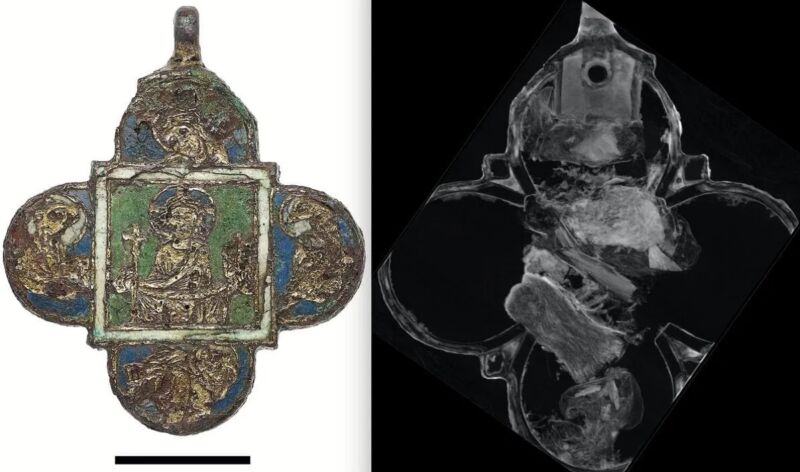Neutron imaging revealed the secrets of this gold-plated medieval pendant

Enlarge / Scientists used neutron tomography to peer inside a medieval pendant, revealing five reliquary packages. (credit: Sabine Steidl, RGZM/Burkhard Schillinger, MLZ)
In 2008, archaeologists excavating a medieval refuse pit in Mainz, Germany, discovered a heavily corroded pendant likely made in the late 12th century. But they were loath to open the pendant to find out what might be inside, lest they damage an already fragile artifact. Now technology has come to the rescue. Researchers from the Technical University of Munich scanned the pendant using neutron tomography, among other methods, and discovered it contained bone splinters-likely religious relics, i.e., the purported bones of saints. The findings were published in the interim meeting of the International Council of Museums-Committee for Conservation (ICOM-CC) Metals Working Group.
Neutron tomography works much the same way as X-ray and gamma-ray imaging methods, except it uses a neutron beam. A target object is shot with a beam of radiation, and some parts interact with the sample while others pass through. The ones that pass through collide with an imaging target to create what's known as an attenuation pattern-essentially an image of the interior of the sample. Neutron tomography is not as sensitive to the density of materials as X-ray and gamma-ray imaging, and unlike those methods, neutrons interact strongly with very light elements like hydrogen. So some things easily visible with neutron imaging may be challenging or impossible to see with X-ray imaging (and vice versa).
The techniques can be complementary and are especially useful for imaging archaeological or paleontological artifacts because they don't damage or destroy the original object. For instance, in December 2021, researchers combined X-ray microtomography-which involves using X-rays to make cross-sections of a physical object-and neutron tomography to create a highly detailed 3D model of a 365 million-year-old ammonite fossil from the Jurassic period, revealing internal muscles that have never been previously observed. Among other findings, they observed paired muscles extending from the ammonite's body, which they surmise the animal likely used to retract itself further into its shell to avoid predators.